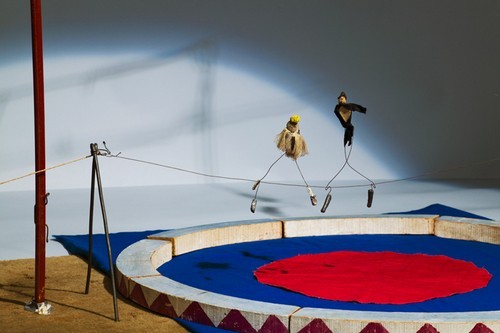Alexander Calder
16 Oct 2008 - 15 Feb 2009

© Alexander Calder
Tight Rope Artists from 'Calder's Circus', 1926-31
Wire, cloth, graphite, leather, lead, paint, and string
Dimensions variable.
Whitney Museum of American Art, New York 83.36.48 and 83.36.50. Photo © Whitney Museum of American Art. Alexander Calder © 2008 Calder Foundation, New York / Artists Rights Society (ARS), New York. Photograph by Sheldan C. Collins
Tight Rope Artists from 'Calder's Circus', 1926-31
Wire, cloth, graphite, leather, lead, paint, and string
Dimensions variable.
Whitney Museum of American Art, New York 83.36.48 and 83.36.50. Photo © Whitney Museum of American Art. Alexander Calder © 2008 Calder Foundation, New York / Artists Rights Society (ARS), New York. Photograph by Sheldan C. Collins
ALEXANDER CALDER
"Alexander Calder: The Paris Years, 1926-1933,"
On view October 16, 2008 - February 15, 2009
"For decades [Calder's] Circus, lent by the artist in 1970 to the Whitney Museum of American Art, has set flight to the imaginations of visiting children and adults. Now the museum is celebrating its genesis in "Alexander Calder: The Paris Years, 1926-1933," an exhibition opening on Thursday that brings the young Calder and the giddy ferment of his artistic circle to life."
--The New York Times, October 12, 2008
When Alexander "Sandy" Calder (1898–1976), arrived in Paris in 1926, he aspired to be a painter; when he left in 1933, he had evolved into the artist we know today: an international figure and defining force in twentieth-century sculpture. In these seven years Calder's fluid, animating drawn line transformed from two dimensions to three, from ink and paint to wire, and his radical innovations included openform wire caricature portraits, a bestiary of wire animals, his beloved and critically important miniature Circus (1926–31), abstract and figurative sculptures, and his paradigm-shifting "mobiles."
The Whitney has the largest body of work by Alexander Calder in any museum and is proud to be the exclusive American venue for this landmark exhibition, co-organized with the Centre Pompidou.
"Alexander Calder: The Paris Years, 1926-1933,"
On view October 16, 2008 - February 15, 2009
"For decades [Calder's] Circus, lent by the artist in 1970 to the Whitney Museum of American Art, has set flight to the imaginations of visiting children and adults. Now the museum is celebrating its genesis in "Alexander Calder: The Paris Years, 1926-1933," an exhibition opening on Thursday that brings the young Calder and the giddy ferment of his artistic circle to life."
--The New York Times, October 12, 2008
When Alexander "Sandy" Calder (1898–1976), arrived in Paris in 1926, he aspired to be a painter; when he left in 1933, he had evolved into the artist we know today: an international figure and defining force in twentieth-century sculpture. In these seven years Calder's fluid, animating drawn line transformed from two dimensions to three, from ink and paint to wire, and his radical innovations included openform wire caricature portraits, a bestiary of wire animals, his beloved and critically important miniature Circus (1926–31), abstract and figurative sculptures, and his paradigm-shifting "mobiles."
The Whitney has the largest body of work by Alexander Calder in any museum and is proud to be the exclusive American venue for this landmark exhibition, co-organized with the Centre Pompidou.
